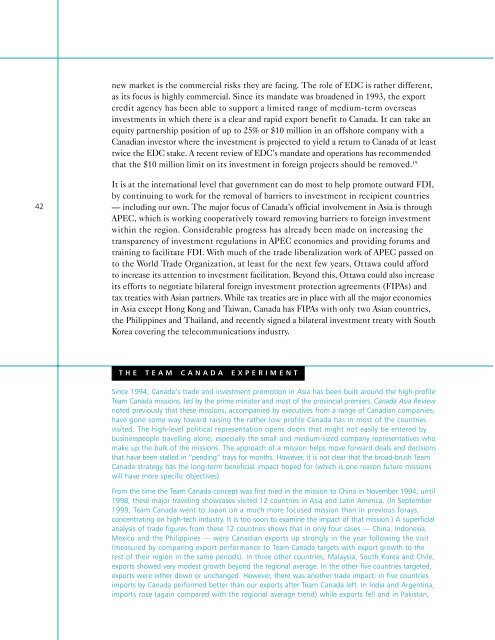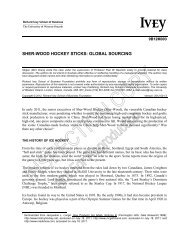foundation of canada asia pacific - Content Tagged with
foundation of canada asia pacific - Content Tagged with
foundation of canada asia pacific - Content Tagged with
You also want an ePaper? Increase the reach of your titles
YUMPU automatically turns print PDFs into web optimized ePapers that Google loves.
new market is the commercial risks they are facing. The role <strong>of</strong> EDC is rather different,<br />
as its focus is highly commercial. Since its mandate was broadened in 1993, the export<br />
credit agency has been able to support a limited range <strong>of</strong> medium-term overseas<br />
investments in which there is a clear and rapid export benefit to Canada. It can take an<br />
equity partnership position <strong>of</strong> up to 25% or $10 million in an <strong>of</strong>fshore company <strong>with</strong> a<br />
Canadian investor where the investment is projected to yield a return to Canada <strong>of</strong> at least<br />
twice the EDC stake. A recent review <strong>of</strong> EDC’s mandate and operations has recommended<br />
that the $10 million limit on its investment in foreign projects should be removed. 19<br />
42<br />
It is at the international level that government can do most to help promote outward FDI,<br />
by continuing to work for the removal <strong>of</strong> barriers to investment in recipient countries<br />
— including our own. The major focus <strong>of</strong> Canada’s <strong>of</strong>ficial involvement in Asia is through<br />
APEC, which is working cooperatively toward removing barriers to foreign investment<br />
<strong>with</strong>in the region. Considerable progress has already been made on increasing the<br />
transparency <strong>of</strong> investment regulations in APEC economies and providing forums and<br />
training to facilitate FDI. With much <strong>of</strong> the trade liberalization work <strong>of</strong> APEC passed on<br />
to the World Trade Organization, at least for the next few years, Ottawa could afford<br />
to increase its attention to investment facilitation. Beyond this, Ottawa could also increase<br />
its efforts to negotiate bilateral foreign investment protection agreements (FIPAs) and<br />
tax treaties <strong>with</strong> Asian partners. While tax treaties are in place <strong>with</strong> all the major economies<br />
in Asia except Hong Kong and Taiwan, Canada has FIPAs <strong>with</strong> only two Asian countries,<br />
the Philippines and Thailand, and recently signed a bilateral investment treaty <strong>with</strong> South<br />
Korea covering the telecommunications industry.<br />
THE TEAM CANADA EXPERIMENT<br />
Since 1994, Canada’s trade and investment promotion in Asia has been built around the high-pr<strong>of</strong>ile<br />
Team Canada missions, led by the prime minister and most <strong>of</strong> the provincial premiers. Canada Asia Review<br />
noted previously that these missions, accompanied by executives from a range <strong>of</strong> Canadian companies,<br />
have gone some way toward raising the rather low pr<strong>of</strong>ile Canada has in most <strong>of</strong> the countries<br />
visited. The high-level political representation opens doors that might not easily be entered by<br />
businesspeople travelling alone, especially the small and medium-sized company representatives who<br />
make up the bulk <strong>of</strong> the missions. The approach <strong>of</strong> a mission helps move forward deals and decisions<br />
that have been stalled in “pending” trays for months. However, it is not clear that the broad-brush Team<br />
Canada strategy has the long-term beneficial impact hoped for (which is one reason future missions<br />
will have more specific objectives).<br />
From the time the Team Canada concept was first tried in the mission to China in November 1994, until<br />
1998, these major traveling showcases visited 12 countries in Asia and Latin America. (In September<br />
1999, Team Canada went to Japan on a much more focused mission than in previous forays,<br />
concentrating on high-tech industry. It is too soon to examine the impact <strong>of</strong> that mission.) A superficial<br />
analysis <strong>of</strong> trade figures from these 12 countries shows that in only four cases — China, Indonesia,<br />
Mexico and the Philippines — were Canadian exports up strongly in the year following the visit<br />
(measured by comparing export performance to Team Canada targets <strong>with</strong> export growth to the<br />
rest <strong>of</strong> their region in the same periods). In three other countries, Malaysia, South Korea and Chile,<br />
exports showed very modest growth beyond the regional average. In the other five countries targeted,<br />
exports were either down or unchanged. However, there was another trade impact: in five countries<br />
imports by Canada performed better than our exports after Team Canada left. In India and Argentina,<br />
imports rose (again compared <strong>with</strong> the regional average trend) while exports fell and in Pakistan,



